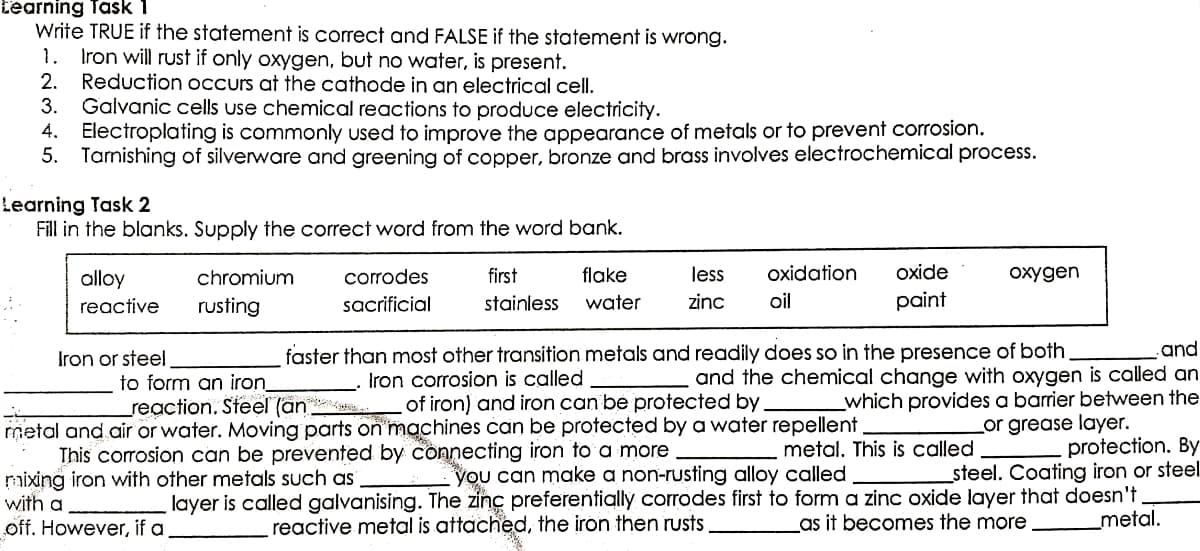Learning Task 1 Write TRUE if the statement is correct and FALSE if the statement is wrong. 1. Iron will rust if only oxygen, but no water, is present. 2. Reduction occurs at the cathode in an electrical cell. 3. Galvanic cells use chemical reactions to produce electricity. 4. Electroplating is commonly used to improve the appearance of metals or to prevent corrosion. 5. Tarnishing of silverware and greening of copper, bronze and brass involves electrochemical process.
Learning Task 1 Write TRUE if the statement is correct and FALSE if the statement is wrong. 1. Iron will rust if only oxygen, but no water, is present. 2. Reduction occurs at the cathode in an electrical cell. 3. Galvanic cells use chemical reactions to produce electricity. 4. Electroplating is commonly used to improve the appearance of metals or to prevent corrosion. 5. Tarnishing of silverware and greening of copper, bronze and brass involves electrochemical process.
Introductory Chemistry: An Active Learning Approach
6th Edition
ISBN:9781305079250
Author:Mark S. Cracolice, Ed Peters
Publisher:Mark S. Cracolice, Ed Peters
Chapter19: Oxidation-reduction(electron Transfer) Reactions
Section: Chapter Questions
Problem 60E
Related questions
Question
C(11)
Please help me answer this one! I need an urgent answer for this.

Transcribed Image Text:Learning Task 1
Write TRUE if the statement is correct and FALSE if the statement is wrong.
1. Iron will rust if only oxygen, but no water, is present.
2. Reduction occurs at the cathode in an electrical cell.
3. Galvanic cells use chemical reactions to produce electricity.
4. Electroplating is commonly used to improve the appearance of metals or to prevent corrosion.
5. Tarnishing of silverware and greening of copper, bronze and brass involves electrochemical process.
Learning Task 2
Fill in the blanks. Supply the correct word from the word bank.
oxygen
alloy
reactive
chromium
rusting
corrodes
sacrificial
first
flake
stainless water
less oxidation oxide
zinc oil
paint
Iron or steel
to form an iron
2
and
faster than most other transition metals and readily does so in the presence of both.
Iron corrosion is called
and the chemical change with oxygen is called an
reaction. Steel (an
of iron) and iron can be protected by _which provides a barrier between the
metal and air or water. Moving parts on machines can be protected by a water repellent
or grease layer.
This corrosion can be prevented by connecting iron to a more
metal. This is called
protection. By
raixing iron with other metals such as
you can make a non-rusting alloy called
steel. Coating iron or steel
with a
layer is called galvanising. The zinc preferentially corrodes first to form a zinc oxide layer that doesn't.
off. However, if a
_metal.
reactive metal is attached, the iron then rusts
as it becomes the more
Expert Solution
This question has been solved!
Explore an expertly crafted, step-by-step solution for a thorough understanding of key concepts.
Step by step
Solved in 2 steps

Knowledge Booster
Learn more about
Need a deep-dive on the concept behind this application? Look no further. Learn more about this topic, chemistry and related others by exploring similar questions and additional content below.Recommended textbooks for you

Introductory Chemistry: An Active Learning Approa…
Chemistry
ISBN:
9781305079250
Author:
Mark S. Cracolice, Ed Peters
Publisher:
Cengage Learning

Introductory Chemistry: An Active Learning Approa…
Chemistry
ISBN:
9781305079250
Author:
Mark S. Cracolice, Ed Peters
Publisher:
Cengage Learning